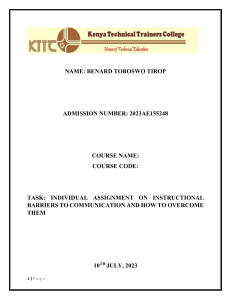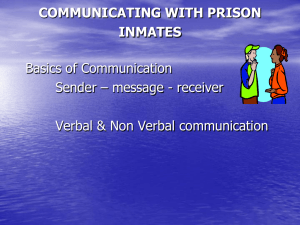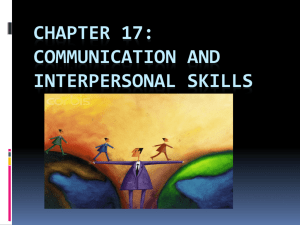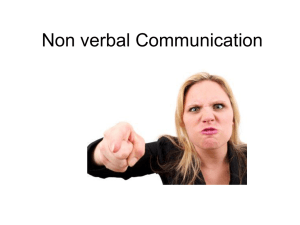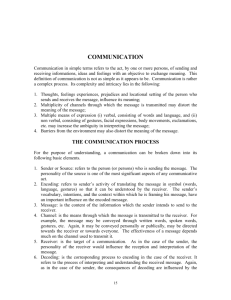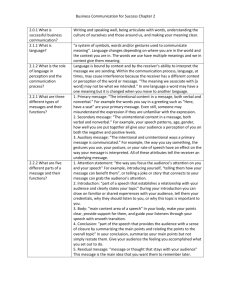Communication
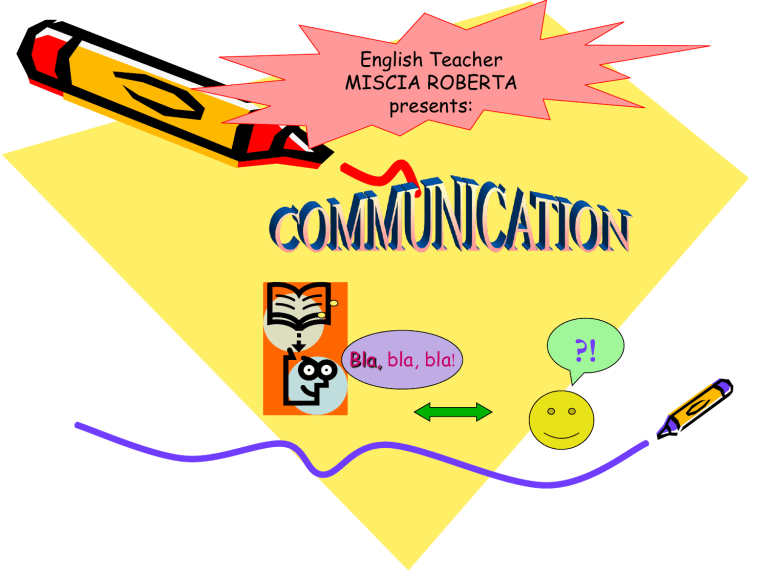
English Teacher
MISCIA ROBERTA presents:
Bla, bla, bla !
?!
Latinate Derivation:
The term“Communication” derives from
A Latin adjective: “communis ” that means “in common”, i.e. something that people share.
To share is to make friends.
Speaking is a “game” of reciprocal influence
Wrong model
Correct model
Forms of Communication
VERBAL / NON VERBAL/ PARAVERBAL
We can speak through:
WORDS
THE BODY
OUR VOICE
EMOTIONS
Thinking “in motion ”: the poles of communication
SENDER
He/she who starts the conversation
MESSAGE
What he/she says
RECEIVER
The person who receives the message
The purpose of communication
Communication is always oriented towards a target :
REACH THE RECEIVER
THROUGH A CANAL
WITHIN A CONTEXT .
This process is called :
FEEDBACK
BASIC QUESTION:
Why do we speak?
a) to inform b) to persuade c) to entertain people
MIND MAP
Visual supports: facial expressions
How to organize words to win the audience’s attention
Thinking in motion
The voice and its secrets
Speaking The body language
The storm of emotions
How communication works:
Any speech act defines the sender and the receiver’s roles: a) the sender sends a message with his/her body and voice, b) the receiver perceives and
interprets it, by means of a canal, c) at last the receiver decides what
to answer (feedback).
The standard iter of communication
Senders : want to communicate 100%
They manage to communicate
70%
Receivers : receive 50%
They understand 20%
They remember 10%
3 rules to succeed:
1.
To be a good speaker is not to be brilliant but to be able to convince the listener to do what I intend to communicate.
2.
To communicate well I must be able to control my body, my voice,
my face expressions, the words, in short, all my reactions.
3.
Before speaking, I must concentrate on
my goals, on the receiver’s point of view and on his/her possible objections.
The ‘
What
’ and the ‘
How
’ of communication
The canals of communication:
Verbal 7%:
The words we use
Paraverbal 38%:
The voice we use
Non verbal 55%:
Our body
Non verbal communication
Facial expressions: match adjectives and photos : thoughtful sweet funny serious happy
Our face has got 187 muscles. People say that the face is the mirrow of the soul, this is quite true, considering that it is really difficult to mask negative sentiments, like: anger, fury, but also other positive ones, like joy or surprise. A person who shows a smile or is happy, while speaking, will certainly result nicer than another one whose face looks cold or indifferent.
The body language
“The language of the body is the key to get to the soul”
(
K.S. Stanislavskij
)
Also the choice of colours says something about the way we are!
Horizon
Colours
Fire
God
Serenity
Sunset
Also a photo can “speak”…
Which words would you match with it?
Vastness
Harmony
Freedom
Creation
Life
Eternity
Joy Beauty Greatness Island Dream
Visual Communication
Read an icon:
•What does the picture show?
•How many people can you see?
• Are they all men?
•Who are they?
•Where are they?
•What is Jesus doing with his hands?
•Which colour is dominant? Why?
•What can Jesus be saying to his apostles?
• Who is the figure in the background who is not eating with the others? Why is he in the shadow?
The origin of gestures
-
-
-
-
-
-
-
Studies and research prove the existence of present gestures also in ancient times. The Romans, for example, were the first to use their thumb standing up or going down to indicate their final verdict towards the gladiators in the arena of the Colusseum, that was death or life.
Another gesture of common usage is to say ‘No’ with our head, by turning it right and left. This gesture seems to derive from the baby’s gesture to refuse the maternal bosom. Other gestures, instead, belong to different cultures and they get different meanings according to the contexts in which they are expressed.
The English ethnologist , follows :
Desmond Morris , has classified gestures as innate
, such as as a smile or a cry , open , such as the crossing of our fingers , assimilated , that is to say, copied by other individuals , learnt , by means of a process of direct observation , expressive , such as a smile or a grimace , mimic , by means of which we try to imitate actions or objects ; symbolic , by which we try to communicate ideas or states of mind .
Non verbal Communication
The capacity to communicate with other individuals of the same species is a characteristic which does not simply belong to people, but also to animals.This kind of language, apparently more primitive, can express emotions and sentiments, communicate orders or exhortations, accompany words increasing their connotation, effectively replace entire speeches.
As Sigmund Freud said:
“No human being can keep a secret. If his/her lips are silent, the tips of his/her fingers speak; they betray the
message he/she intends to convey ”.
Our gestures can be intentional, which means born by the will to communicate some information to the observer, or they can be fortuitous, that means the unconscious expression of emotions or clues of a situation that the observer must catch and interpret.


